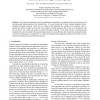Free Online Productivity Tools
i2Speak
i2Symbol
i2OCR
iTex2Img
iWeb2Print
iWeb2Shot
i2Type
iPdf2Split
iPdf2Merge
i2Bopomofo
i2Arabic
i2Style
i2Image
i2PDF
iLatex2Rtf
Sci2ools
SIBGRAPI
2003
IEEE
2003
IEEE
A Non-Self-Intersection Douglas-Peucker Algorithm
The classical Douglas-Peucker line-simplification algorithm is recognized as the one that delivers the best perceptual representations of the original lines. It is used extensively for both computer graphics and geographic information systems. There are two variants of this algorithm, the original Ç´Òѵ method, where Ò denotes the number of input vertices and Ñ the number of output segments, that works in any dimension, and the Ç´Ò ÐÓ Òµ one, which only works for simple 2D planar polylines. In the both variants, a self-intersecting simplified line may be yielded if the accepted approximation is not sufficiently fine. Based on star-shaped subsets, we present in this paper yet another Ç´ÑÒµ variant of Douglas-Peucker algorithm which preserves the non-selfintersection property for any predefined tolerance.
Computer Graphics | Douglas-Peucker Line-simplification Algorithm | Original Ç´Òѵ Method | SIBGRAPI 2003 | Simple 2D Planar |
| Added | 05 Jul 2010 |
| Updated | 05 Jul 2010 |
| Type | Conference |
| Year | 2003 |
| Where | SIBGRAPI |
| Authors | Shin-Ting Wu, Mercedes Rocío Gonzales Márquez |
Comments (0)

